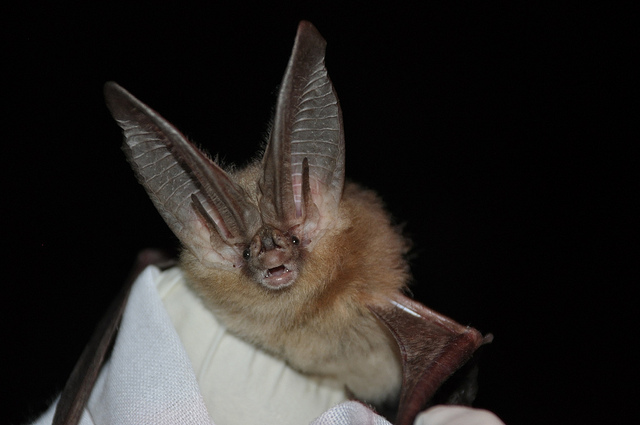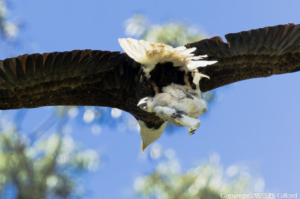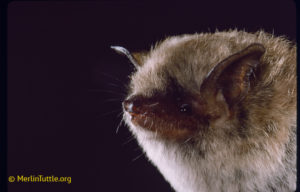Move over, birds. There is another flying – albeit more elusive– species drawing summer crowds.
Warmer weather and longer twilights make it ideal to watch some of the coolest little critters in the Bay Area — bats!

Here are the facts. There are 24 species of bats in California and they’ve nudged their way into just about every kind of land habitat — mountains, deserts, and even urban neighborhoods. Between 12 to 16 bat species call the San Francisco Bay Area home.
Not impressed enough by these flying mammals? Well, how about this. Almost one-quarter of the world’s 4,400 species of mammals are bats.
“Bats can really be found anywhere if you’re looking,” says Cat Taylor, a naturalist with the East Bay Regional Park District. “Since they primarily feed on small insects, they are mainly around lakes, rivers and streams, but they’ll hang out around streetlights around your neighborhood or anywhere else there are insects.”
Think of bat watching as a way to appreciate, for a moment, all that these little critters do for us. Dismiss preconceptions about bats being ruthless, bloodsucking harbingers of disease. Yes, there are the occasional cases — such as the recent scare at a Mendocino yoga retreat where some seven Bay Area residents are being treated for possible rabies infection after exposure to bats. At Lake Merced, San Francisco Health officials are warning people about bats that recently tested positive for rabies.
But bats are generally shy, intelligent creatures that are important to our ecosystem and are of considerable benefit to humans. They are natural pest controllers, pollinators and fertilizers.
Dusk and early dawn are the best time to watch bats. The longer twilights of summer make for particularly good viewing conditions, and the warmer weather ensures all the bats are out and about town, instead of in hibernation or migration.
Although bats are everywhere, to guarantee seeing them, head to a body of fresh water at sunset and look to the brightest part of the sky, says Taylor. Western pipistrelles are among the first bats to come out and even fly in daylight. One of the top spots in the Bay Area to watch bats is Lake Del Valle in Livermore.
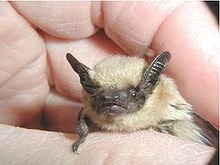
“If you are sitting on the edge of the lake, 10 to 15 minutes after sunset, you are in a bat commuter zone,” says Taylor. “It’s like being on the Bay Bridge at 7:30 a.m. and everyone’s going to work.”
Bats can also be seen in the wee hours of the morning. If you’ve adopted a semi-nocturnal lifestyle and are heading home around 4 am, you’re in good company. Bats generally feed for brief periods at a time, return home to rest, then head back out to snack before turning in for good at dawn.
And they aren’t just zipping overhead. If you are nearby a body of water, bats are lurking everywhere you imagine: under loose bark, in crevasses of rocks, behind signs, or in rodent holes in the ground.
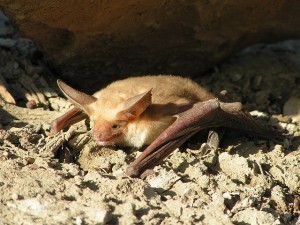
Bats are extremely diverse in every possible way: size, how they forage, where they live and what they eat. Some fruit bats pollinate flowers, and the pallid bat hunts scorpions–and is immune to its venom–making it a ground dweller most of the time. Say what? Bats on the ground?!
Know the phrase, “blind as a bat”? Dismiss that one as well. Bats see very well. In fact, the California leaf-nosed bat has night vision far superior to the best man-made night scope. The need for echolocation was born not out of blindness, but to maximize hunting yields in the dark.
Bats’ hearing is so advanced that the high-pitched sound waves that bounce off objects and back don’t just tell the location of an insect or fruit, it tells them whether it is their favorite variety. Since insects can hear the bat calls and evade getting caught, bats will generally rely on their eyes to find prey until the last minute.
Echolocation doesn’t just help bats find their prey, it helps us find bats. Once you identify the high-pitched calls and squeaks, you can track bats in the night sky. When watching bats, be respectful. Be sure to watch quietly and avoid shining flashlights at the animals. The best method is to set up lawn chairs, relax and try not to be obtrusive.
“Be as non-disruptive as possible,” says Taylor. “If you’ve done anything to make an animal change its natural behavior, you’ve done something wrong.”
Here are our top picks on the best places to watch bats in the Bay Area:
East Bay Regional Parks:
Lake Del Valle, Livermore
7000 Del Valle Road, Livermore, CA, 94550, (888) 327-2757
Park gate closes at 9, but curfew is 10 p.m., so you can park and walk in.
Shadow Cliffs Regional Recreation Area, Pleasanton
2500 Stanley Boulevard, Pleasanton, CA 94566, (925) 846-3000
San Francisco:
Lake Merced
Several entrances off Lake Merced Blvd, John Muir Blvd and Skyline Blvd. Suggested trail: Lake Merced Rim
Stow Lake, Golden Gate Park
Stow Lake Drive, SF, CA 94119
Sacramento-Davis:
Perhaps the best place to see bats in one fell swoop is the Yolo Causeway, halfway between Davis and Sacramento. At the beginning of every June, 250,000 Mexican free-tailed bats migrate to the 3-mile long causeway, where they roost during the daytime and emerge at twilight in massive numbers. It’s one of this species’ largest colonies in California. [The Davis Enterprise]

